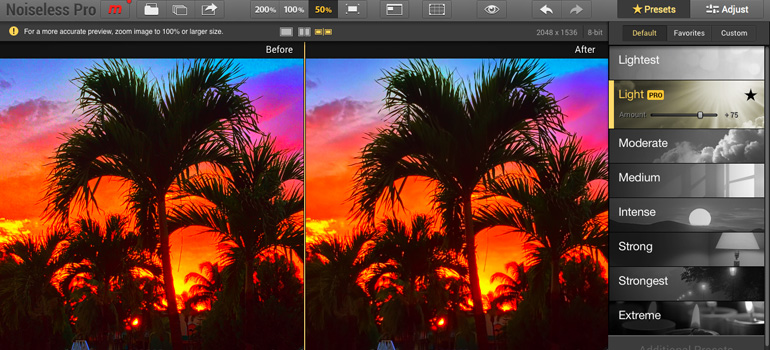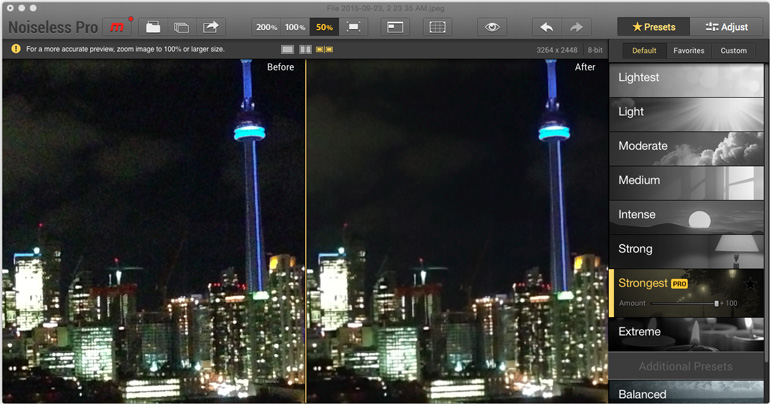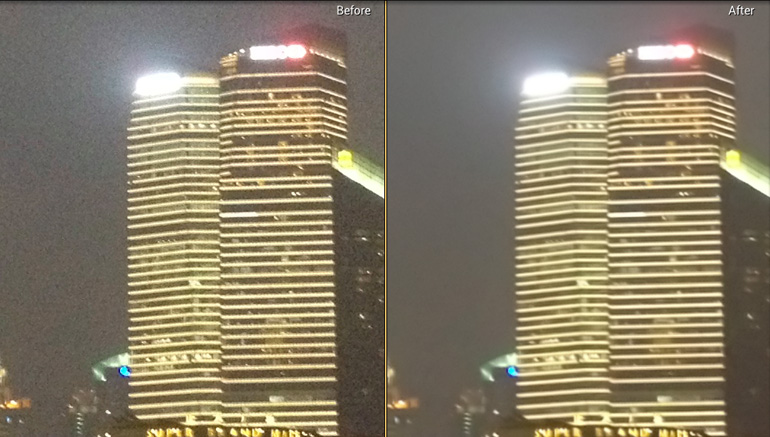
Noise, especially in low-light or nighttime photos, can take away from their beauty and composition, and thus requiring stringent editing to smooth everything out. Macphun’s Noiseless is desktop software that aims to do that in a way that even beginners can manage with ease. With a user-friendly interface and real-time results, it’s an impressive program that delivers more often than not.
For this review, I tested Noiseless Pro, which offers more professional capabilities photographers and serious amateurs would appreciate, but the regular version contains much of the same functionality.
The premise here is simple: reduce noise in a way everyone can understand. Noise is the spotty grain that saturates a photo when shutter speed is low and ISO high to capture as much light as possible to compose an image. The problem, particularly with higher ISOs, is that noise tends to creep in and cover the photo like bits of snow. Removing this while maintaining most of the image’s original detail is challenging with the best tools, and it can be painstaking work.
What Noiseless is driven to do is lessen the trade-off of noise vs. detail and help to not only salvage images, but also enhance others. The software is entirely scalable, meaning that you can go as light or as heavy as you want to in applying the noise-reduction. There are eight default presets in all ranging from Lightest to Extreme. When loading a photo into the software, it will automatically choose among them for what it thinks is the best fit. It’s not bulletproof, so there is always the compunction to go it alone.

Sliders figure prominently here, both in the intensity of each preset and the divider that allows for a quick comparison to see how the effect impacts certain parts of a photo. Zooming in is easy with 200%, 100% and 50% buttons clearly laid out at the top. A side-by-side comparison is also possible at each of those magnifications.
The Favorites column is just a preset and intensity level that you like. Clicking the star when using one of them by default will save it in Favorites. Above the columns is an Adjust tab that offers more precise tools. Clicking Create at the bottom then places it in the Custom column.
The simplicity in how the software works should be a draw to photographers of all stripes. Beginners may need more time to understand what the various features do, but the visual result vis-à-vis the tinkering sliders is unmistakable.
Having been in a position where dealing with noisy images has been frustrating or tools lacked the kind of precision necessary to avoid losing an inordinate amount of detail, Noiseless proved to be a treat. But it was a treat because it did a good job. The nicely laid out interface and user-friendly navigation would be useless without its core function being worthy.
What’s especially interesting is the way in which Noiseless manages to diffuse the effect of noise without completely blurring the image. The preset and intensity are the critical elements, but even with that, what you plan to do with the photo needs to be taken into account. You can take more liberties with the image you want to share on Instagram then the one that will be printed and framed. Scale and size do matter when it comes to that because of how and where the image is viewed.
Photos from smartphones are notorious for creeping noise in low-light conditions because the Auto and Night modes tend to crank up the ISO in order to give you something you can see. I’ve seen more than a few images ruined by this hand-holding gesture on the part of the manufacturers, and it led me to wonder if Noiseless could salvage those. Yes and no. Low-res JPEGs have fewer pixels to work with, generally, so while the software can do its job, it can’t work miracles when there’s less to work with.

This is why I found better results with high-res JPEGs and RAW images. The more detail, the more profoundly precise the effect of noise removal without stripping an image bare. Not surprisingly, Noiseless has a plug-in that makes it accessible directly from Adobe Photoshop, Photoshop Elements, Lightroom and Apple’s Aperture.
That’s a nod to professionals, but is also relevant to novices, too. Elements is essentially Photoshop Lite, and regardless of where Noiseless fits in, any editing before or after the noise reduction will require a photo-editing app of some kind. It’s not possible to make even minor changes to the exposure, saturation or curves, much less use layer masks or repair something in it.
That makes Noiseless a complimentary photo-editing tool that does one particular thing really well. Specializing in one task, important and useful as it may be, may give users pause on the cost of entry. The regular version is $12 on the Mac App Store, while the Pro version is a $49 upgrade. Buying Pro standalone is even more expensive at $79, so the incentive to upgrade is obvious when saving $18.
If you’re not a professional photographer, you don’t need to invest in the Pro version. The regular one will serve you fine. If you have a number of photos from past trips or shooting sessions that could use some noise reduction, this is perhaps the best program I’ve seen for doing that.



